- 1Department of Aerospace Engineering and Technology, Space Engineering University, Beijing, China
- 2Lab of Quantum Detection and Awareness, Space Engineering University, Beijing, China
- 3Department of Physics and Collaborative Innovation Center for Optoelectronic Semiconductors and Efficient Devices, Xiamen University, Xiamen, China
- 4Department of Basic Course, Space Engineering University, Beijing, China
Structured light beams such as optical vortices can carry the orbital angular momentum (OAM) with an unbounded quantum number. Recent years have witnessed a growing interest in the rotational Doppler effect with vortex light. Here we present an overview on the technical progress in measuring the rotational Doppler effect associated with OAM. This includes how a high-order OAM light beam is crucial for realizing high-sensitivity remote sensing of rotating objects. The basic physical mechanism of rotational Doppler effect is manifested from both perspectives of the wave property and the conservation law of energy. Besides, we summarize the extension of the rotational Doppler effect from linear optics to nonlinear optics, and to quantum realms. Also, we discuss the main challenges and opportunities of angular remote sensing in a realistic scenario for future applications.
Introduction
What would happen when placing a watch at the center of a rotating turntable, and viewed from above? Obviously, the watch hands will speed up or slow down depending on the rotation direction of the turntable [1]. If one applies this effect to all rotating vectors, for example to the spatial pattern of the electric field of any light beam carrying angular momentum [2–4], the additional rotation of the beam will result in a frequency shift proportional to the rate of rotation of the beam [5, 6]. This is the direct understanding of the rotational Doppler effect (RDE).
At first, this effect was found related to the circular polarization (CP) of the photon and was called the angular Doppler effect [7]. When the CP photon interacts with the rotating matter, the interchanges of rotational kinetic energy will bring a rotational frequency shift of
After a simple coaxial superposition between the LG beam and the Gaussian beam, the RDE frequency shift can be observed directly due to the beat frequency phenomenon [5]. The technique of the superposition beam is soon widely used in RDE observation and OAM recognition [6, 18–20]. Especially, people can generate any superposition mode and high-order OAM beam with the development of spatial light modulators [21]. If the two components of the superposition beam have the same OAM number but opposite signs, this superposition beam can be called the phase-conjugated beam which has the self-interference property and is immune to the influence of the linear motion [22, 23]. These concepts were soon extended from linear optics to nonlinear optics and even quantum physics and many new applications have been derived [24–27].
In the 40 years of development since the concept of angular Doppler effect was first proposed, the RDE associated with structured light has established itself as one of the most interesting topics in structured light sensing applications, with relevance from spin to orbital angular momentum, from linear optics to nonlinear optics, even in the quantum optics and elsewhere. The method of rotational speed measurement based on the rotational Doppler effect applies to both microscopic particles and macroscopic objects. In the ongoing research, it is believed that this effect will bring more surprise to people.
The Basic Mechanism of Rotational Doppler Effect
The Interpretation From the Wave Properties
In 1842, the Austrian physicist Christian Doppler proposed that the wavelength of the radiation of an object will change due to the relative motion of the wave source and the observer, that is, the Doppler effect. When the object moves in a certain direction at a constant speed
where
For a beam with helical phase, its Poynting vector, and hence the optical momentum, has an azimuthal component at every position within the beam. The angle
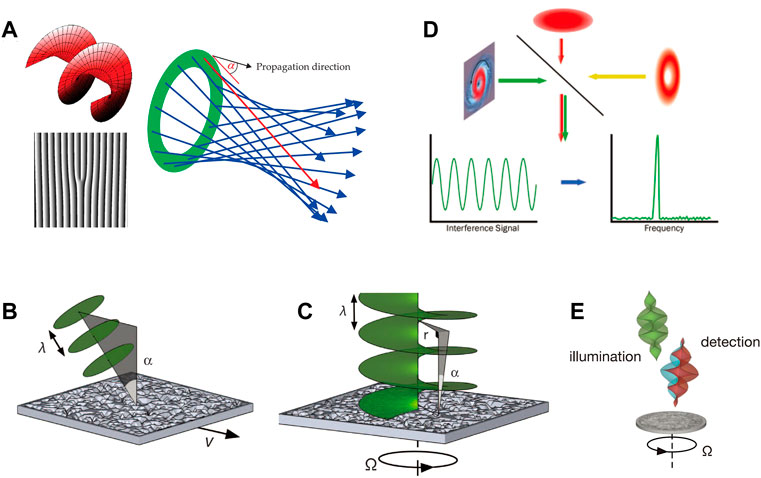
FIGURE 1. The wave properties of optical vortex and the measurement of RDE frequency [30] (A) The Poynting vector of the vortex light (B) Translational Doppler frequency shift and (C) rotational Doppler frequency shift [31] (D) The detection scheme of the rotational Doppler shift with structured light [36] (E) A superposition of helically phased beams with opposite signs of
On one hand, the RDE can be seen to have the same origin as the traditional LDE [32]. On the other hand, there is a significant difference between the LDE and RDE, namely, RDE frequency shift is independent of the wave frequency of the detected beam, such that the RDE can be observed using a white-light source [33]. Actually, the same RDE frequency shift also can be observed in the OAM-based radar [34, 35].
Since the light frequency is too high to be detected, like the conventional laser Doppler velocimetry, the RDE frequency shift can be observed by the interference phenomenon. As shown in Figure 1D, through the interference between the scattered beam and the reference beam, this frequency shift can be observed by extracting the beat frequency. Besides, when the illuminating light comprises two helically phased beams with topological charge
The above interpretation only considers the rotation of the object. When the scatter has a compound motion of linear motion and rotation, the particles in the vortex field would experience both linear and rotational Doppler frequency shift. This can be understood from the phase change of the vortex field. The incident radiation wave can be simply written as,
where the longitude phase is determined by propagation distance
where
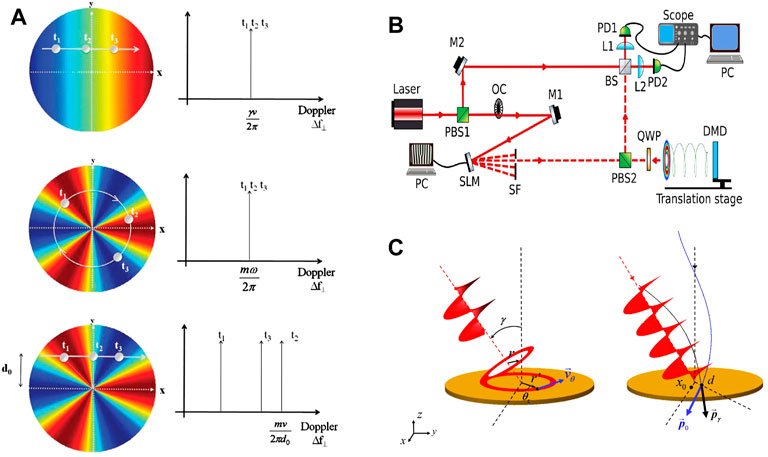
FIGURE 2. (A) The production of Doppler effect with structured light [37]. (B) Compound motion detection scheme [38]. (C) Rotational Doppler effect at vortex light oblique incidence [23].
Furthermore, the above deduction is effective only on the condition that the beam illuminates on the axis of the rotating object. When the vortex illuminates the rotating body non-coaxially as shown in Figure 2C, the RDE behaves differently. The radius of the vortex light and the radius of each small scatter on the rotating body under the light field are always the same when the vortex light illuminate the rotating object on its axis, while these two radii are unequal when the light illuminates non-coaxially. Based on the small scatterer model, Qiu et al. deduced the rotational Doppler shift when there is a small lateral misalignment or oblique angle between the vortex axis and rotating axis, respectively [23, 39]. The corresponding RDE frequency shift is given by,
where
The Energy Transfer in RDE
It is also instructive to understand the RDE from the conservation laws of energy and angular momentum when photons interact with the medium. For a rotating particle, the rotational kinetic energy due to the rotational motion can be expressed as,
where
In the case of rotation, a system composed of rotating particles and the photons obeys the kinetic energy conversion, namely [7, 40],
where
During the emission or absorption of photons by atoms, the energy transfer can be expressed by
For the systems interacted by beams and rotating particles, there is also a momentum conservation relationship,
where
where
By combining Eqs 8–10, we can obtain the RDE frequency shift as,
If the scattered light to be detected is in the fundamental Gaussian mode, i.e.,
In the nonlinear regime, the perspective of energy and momentum conservation also can be used to interpret the origin of RDE. When the circularly polarized beam passes through a spinning nonlinear optical crystal with three-fold rotational symmetry, the beam would experience a Doppler shift of three times that of the optical crystal [24]. Furthermore, based on the mirror symmetry for electromagnetic interactions, the RDE frequency shift can be doubled through cascading two rotational Doppler processes [25]. This cascaded RDE can also be understood according to the law of conservation of momentum.
The magnitude of the frequency shift is proportional to both the topological charge and the rotational speed, as can be directly seen from the RDE formula. In order to ensure the frequency shift can be measured, this scheme is more available for measuring objects rotating at high speed rather than low speed [42]. On the other hand, the RDE frequency is also proportional to the topological charge of the illuminating beam; therefore, the detection sensitivity can be increased by using higher-order OAM beams. Up to now, a myriad of approaches have been developed for the generation of higher-order OAM beams, demonstrating up to
Application of Rotational Doppler Effect
RDE in the Rotational Motion Detection
Since Allen et al. proposed their inspiring scheme of the detection of a spinning object by using light’s orbital angular momentum, there have been massive relevant research literatures in this area. In addition to the rotational speed, other rotation parameters such as rotating direction and acceleration rate have been measured as well. Since the beat frequency effect can only provide the magnitude of the frequency shift without the direction information [46], the acquisition of the rotation direction becomes a tricky problem. Rosales-Guzman et al. devised a scheme to impart an additional rotation on the illuminating vortex beam, which can give a reference to identify the rotation direction [47]. By employing dual-frequency vortex light, as shown in Figure 3A, Li et al. transform the Doppler signals from the low-frequency domain to the medium-frequency domain, and thus distinguishing the rotational direction by comparing the modulated signal and the reference signal [48].
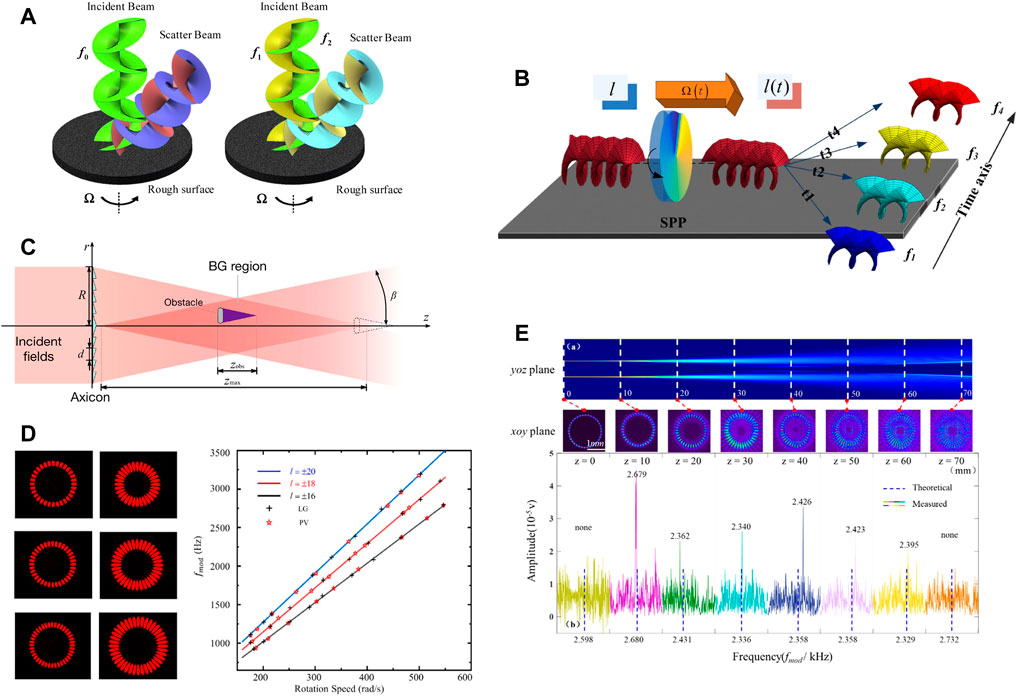
FIGURE 3. RDE in rotational speed detection. (A) Direction-sensitive detection by dual-frequency optical vortex [48]. (B) Detection of angular acceleration based on optical RDE [51]. (C) Non-diffractive Bessel-Gaussian beams for the detection of rotational speed [57]. (D) RDE detection results by using perfect optical vortex [58]. (E) The measured results of RDE frequency shift along the propagation path of ring Airy Gaussian vortex [59].
Recently, the vectorial counterpart of RDE was revealed, which uses vectorial polarization fields and shows the potential to retrieve the full vectorial motion information of the moving object [49, 50]. The above measurements are based on the constant rotation velocity. While for variable rotation, Zhai et al. succeeded in measuring the angular acceleration through a time-frequency analysis of the RDE frequency shift [51]. The transformation of OAM beams when passing through a non-uniform spinning SPP is shown in Figure 3B.
At present, the accuracy of RDE-based speed measurement is relatively high, generally reaching over 95% [31, 33, 47]. Even under the light noncoaxial incidence condition, the rotational speed still can be measured in a high accuracy through the extraction the frequency difference in the discrete frequency shift signals [52]. However, the accuracy of the speed measurement also fluctuates in response to changes in measurement conditions [53]. Moreover, since the frequency shift caused by the RDE is proportional to the object’s angular velocity, in order to ensure the frequency shift can be measured, this scheme is more available for measuring objects rotating at high speed rather than low speed [54]. The rotational speed can be measured in most laboratory conditions is larger than
RDE Introduced by Different Types of Vortex Beams
Researchers have tried using different types of structured vortex beams to investigate RDE, including Laguerre–Gaussian (LG) beam [31], Bessel-Gaussian (BG) beam [57], Perfect Optical Vortex (POV) beam [58, 60, 61], and Ring Airy Gaussian Vortex (RAiGV) [59]. The LG beam is the most popular structured light used in the RDE detection which can stably propagates over a long distance. The transverse beam profile is a single intensity ring with zero radial index
Also, POV have recently attracted a lot of research attention, owing to its characteristic feature that they have the same intensity profile regardless of carrying different topological charges, as is shown in Figure 3D [58]. Therefore, the POV beam is more flexible when detecting the objects of different sizes. In particular, when the topological charges of the two components of a superposition beam are not the same magnitude, the POV performs better than the LG beam [58]. It was reported that, as is shown in Figure 3E, the RAiGV has the same well performance in spinning speed detection as other vortex beams [59]. Besides, the RAiGV beam has self-focusing property, which enables the best detection results on its focal length. These researches fully considered the RDE detection effect of the different types of vortex beams, which offers useful instructions in choosing suitable vortex beams for realistic applications.
RDE in Compound Motion Measurement
In the actual applications, we usually encounter the compound motion, e.g., translation, rotation, and other kinds of micro-motion. Accordingly, the scattered light would experience LDE, radial Doppler effect [63], RDE, and micro-Doppler effect [64, 65]. These frequency shifts are generally coupled to each other. Thus, a question arises naturally as to how we can measure them individually. It was reported that the translational and rotational velocities of the particles can both be determined by switching between two modes. They were able to isolate the longitudinal frequency shift by illuminating a Gaussian beam while measure the rotational frequency shift by using LG modes. In 2019, Carmelo et al. put forward a novel three-dimensional technique that enables the direct and simultaneous measurement of both the longitudinal and angular speed of cooperative targets [66], as was shown in Figure 4A.
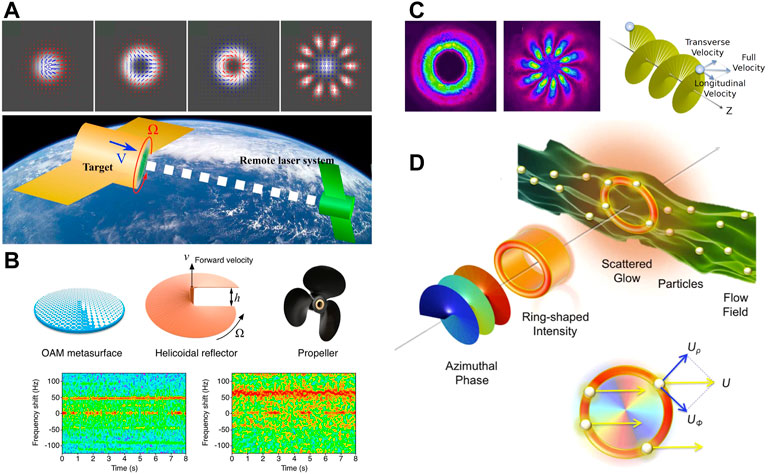
FIGURE 4. Compound motion detection by RDE of structured light. (A) In-suit detection of a cooperative target’s longitudinal and angular speed using structured light [66]. (B) Experimental observation of linear and rotational Doppler shift from several designer surface [67]. (C) Measuring the translational and rotational velocities of particles [38]. (D) Measurement of flow velocity with helical beams of light [69].
The rotational Doppler shift could be separated from the micro-Doppler shift by using two microwave beams of opposite OAM [67]. Figure 4B shows the spectrogram of a normal 5.8 GHz incident wave reflected from a spinning helicoidal reflector, and the scattered waves produce both linear and rotational Doppler shifts. Figure 4C reveals the reason why a particle moving along a spiral trajectory will produce both linear and rotational frequency shifts. By employing the OAM interferometry of the multi-mode beam, decoupled measurement of linear velocity and rotational speed can be achieved [55, 68]. These methods can partially resolve the decoupled measurements of the compound motion with OAM beam. It is expected that the use of multidimensional information about light beams may provide new solutions to this engineering challenge in the future.
It was found that not only the rotational speed, but also the flow velocity could be accurately estimated by making use of the transversal Doppler effect of the returned signals that depend only on the azimuthal indices of the vortex beams [69], as was shown in Figure 4D. Also, the fluid flow vorticity could also be measured in a straightforward way by taking advantage of the RDE [70], which allowed for a localized real-time determination of vorticity in a fluid flow with three-dimensional resolution.
RDE in Nonlinear and Quantum Optics Field
When the circularly polarized beam passes through a spinning nonlinear optical crystal with three-fold rotational symmetry, it was found that the second harmonic generation signals may experience a Doppler effect of three times the spinning speed [24]. Figures 5A,B illustrate the RDE in the linear and nonlinear optical regime. This demonstration of RDE provided us with an insight into the interaction of light with moving nonlinear media. By using the post-selection and beating frequency techniques, researchers further simplified the conventional nonlinear RDE measurement setup and successfully observed the RDE of second harmonic generation waves [71]. As shown in Figure 5C, when the forward propagating fundamental wave with left- and right-circular polarization pass through the spinning nonlinear material with three-fold rotational symmetry, the RDE frequency shift is three times of the spinning speed [71]. Besides, the RDE also can be detected by using the near-infrared light to illuminate the rotating object, in which the rotational frequency shifts can be transferred to the visible regime after parametric up-conversion [72]. The corresponding up-conversion detection scheme is shown in Figure 5D.
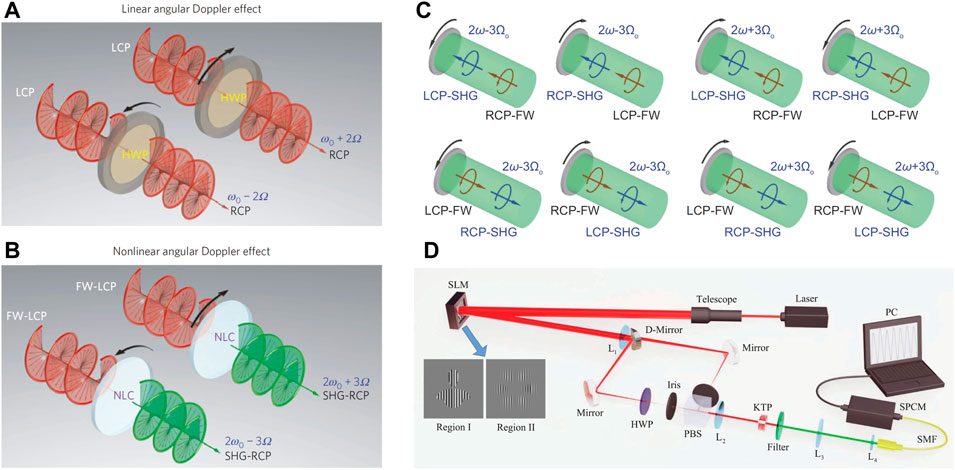
FIGURE 5. RDE in nonlinear optics. RDE in (A) linear and (B) nonlinear optics. The second harmonic generation signal experiences a Doppler shift of three times [24]. (C) The evolution of RDE of second harmonic generation from a quartz coated with silver mirror [71]. (D) RDE detection by frequency up-conversion [72].
In addition to those classical methods, quantum remote sensing with OAM-entangled photon pairs enabled an improved angular resolution that can be amplified by large OAM values [73]. By using photonic entanglement of high orbital angular momenta, Flicker et al. demonstrated a method of increasing the angular resolution in remote sensing [26]. As shown in Figure 6A, the polarization entanglement is created in a parametric down-conversion process and afterward transferred to modes with high quanta of OAM. Also, Zhang et al. showed that the object’s angular rotational speed can be measured nonlocally, the corresponding experimental scheme is shown in Figure 6B. They revealed that the angular sensitivity of the object in the path of idler photons is proportional to the OAM values of signal photons, which can be considered as a quantum version of RDE [74].
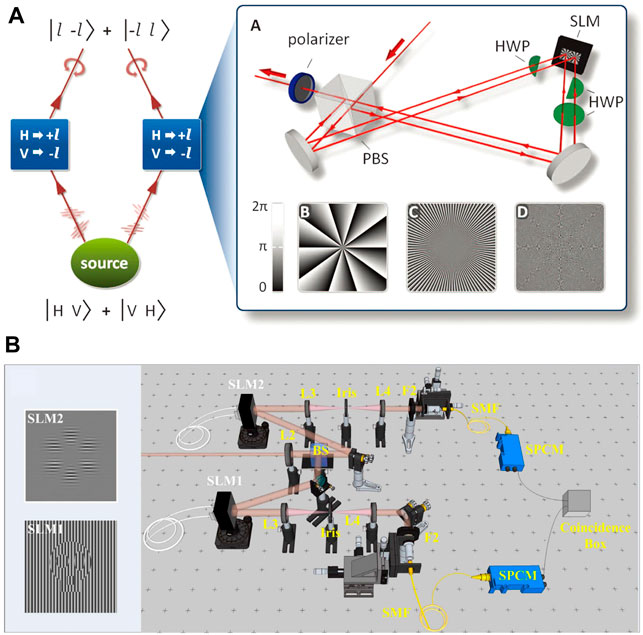
FIGURE 6. RDE in quantum optics. (A) Quantum entanglement of high order angular momenta [26]. (B) Quantum remote sensing of the angular rotation of structured objects [74]. It suggests potential applications in developing a noncontact way for angular remote sensing of object.
RDE in Various Bands
Since the RDE has nothing to do with the wavelength of the detection beam [33]. In recent years, the RDE in the radio domain is investigated widely [65]. Zhao et al. used the phase accumulation method to experimentally verify the RDE in the microwave band [35]. Although the measurement accuracy of the rotational speed is high, phase accumulation takes relatively long time and has certain limitations in practical applications. Similar to the detection technique of the light wave, Brousseau et al. realized the RDE detection of the microwave at 2.47 GHz by the spectrum analyzer [75]. Both the rotational speed and the direction can be measured through this model. The RDE of uniformly accelerated targets has also been studied in the radio frequency band by means of time-frequency analysis [76].
For the microwave band, the signal extraction process when detecting the target is more convenient. However, vortex electromagnetic waves in the microwave band are difficult to propagate over long distances. Structured laser can be transmitted over long distances, but the probe beam is easy to be disturbed by the atmospheric turbulence [77]. Further, the extraction of weak light signals under long-distance detection is more troublesome.
Conclusion and Perspectives
In summary, with the technological advancements in the structured light generation, propagation, manipulation, and detection, we have offered a systematic understanding on the physical origin and behaviors of the RDE, from both fundamental and applied points of view. We have analyzed the basic mechanism of the RDE from the perspective of the wave property of light and the conservation of energy. Moreover, we have summarized the recent developments in rotational speed measurement based on RDE, ranging from the molecular motion to the rotation of macro-objects, and from linear optics to nonlinear optics, and to quantum optical realms.
It is noted that, although a lot of studies have been conducted on the fundamental and applied aspects of RDE, there is still a long way to go in terms of developing a viable system and putting this technique into practical applications. There are various hurdles to solve in order to implement detection from the lab to the outside scale. Firstly, atmospheric turbulence has a significant impact on the mode purity of an OV beam as it propagates across free space [77–81]. This is a challenge that must be solved, both for OAM-based communication and detection applications. Secondarily, the relative pose between the detection OV beam and the rotating object has a significant influence on the detection signal [68, 82–84], therefore the distribution of the RDE signals under different conditions of motion and positions needs to be further investigated. Thirdly, the receiving and processing of signals is an important aspect for the detection system, especially for weak signals at the photon-counting level [54]. Also, as the RDE is independent of the wavelength of the beam [75, 76], we can anticipate that an extension of the RDE into the radar band might lead to some new discoveries. In future studies, we can imagine that the RDE with structured light will provide us with more and more surprises.
Author Contributions
LC and YR conceived the idea. YR and LC supervised the project. SQ combed through the entire relevant literature. All authors discussed the results. SQ and TL drafted the papers with the input from all authors.
Funding
Key Research Projects of Foundation Strengthening Program of China (2019-JCJQ-ZD); National Natural Science Foundation of China (61805283 and 62173342).
Conflict of Interest
The authors declare that the research was conducted in the absence of any commercial or financial relationships that could be construed as a potential conflict of interest.
Publisher’s Note
All claims expressed in this article are solely those of the authors and do not necessarily represent those of their affiliated organizations, or those of the publisher, the editors and the reviewers. Any product that may be evaluated in this article, or claim that may be made by its manufacturer, is not guaranteed or endorsed by the publisher.
References
2. O'Neil AT, MacVicar I, Allen L, Padgett MJ. Intrinsic and Extrinsic Nature of the Orbital Angular Momentum of a Light Beam. Phys Rev Lett (2002) 88:053601. doi:10.1103/PhysRevLett.88.053601
3. Mohammadi SM, Daldorff LKS, Forozesh K, Thidé B, Bergman JES, Isham B, et al. Orbital Angular Momentum in Radio: Measurement Methods. Radio Sci (2010) 45. doi:10.1029/2009rs004299
4. Bialynicki-Birula I, Bialynicka-Birula Z. Rotational Frequency Shift. Phys Rev Lett (1997) 78:2539–42. doi:10.1103/PhysRevLett.78.2539
5. Basistiy IV, Slyusar VV, Soskin MS, Vasnetsov MV, Bekshaev AY. Manifestation of the Rotational Doppler Effect by Use of an off-Axis Optical Vortex Beam. Opt Lett (2003) 28:1185–7. doi:10.1364/ol.28.001185
6. Vasnetsov MV, Torres JP, Petrov DV, Torner L. Observation of the Orbital Angular Momentum Spectrum of a Light Beam. Opt Lett (2003) 28:2285–7. doi:10.1364/ol.28.002285
8. Ashby N. Relativity in the Global Positioning System. Living Rev Relativ (2003) 6:1. doi:10.12942/lrr-2003-1
9. Korech O, Steinitz U, Gordon RJ, Averbukh IS, Prior Y. Observing Molecular Spinning via the Rotational Doppler Effect. Nat Photon (2013) 7:711–4. doi:10.1038/nphoton.2013.189
10. Allen L, Beijersbergen MW, Spreeuw RJC, Woerdman JP. Orbital Angular Momentum of Light and the Transformation of Laguerre-Gaussian Laser Modes. Phys Rev A (1992) 45:8185–9. doi:10.1103/PhysRevA.45.8185
11. Allen L, Padgett MJ. The Poynting Vector in Laguerre-Gaussian Beams and the Interpretation of Their Angular Momentum Density. Opt Commun (2000) 184:67–71. doi:10.1016/s0030-4018(00)00960-3
12. Molina-Terriza G, Torres JP, Torner L. Management of the Angular Momentum of Light: Preparation of Photons in Multidimensional Vector States of Angular Momentum. Phys Rev Lett (2002) 88:013601. doi:10.1103/PhysRevLett.88.013601
13. Padgett MJ, Allen L. Orbital Angular Momentum Exchange in Cylindrical-Lens Mode Converters. J Opt B Quan Semiclass. Opt. (2002) 4:S17–S19. doi:10.1088/1464-4266/4/2/362
14. Allen L, Babiker M, Power WL. Azimuthal Doppler Shift in Light Beams with Orbital Angular Momentum. Opt Commun (1994) 112:141–4. doi:10.1016/0030-4018(94)00484-6
15. Censor D. Theory of the Doppler Effect: Fact, Fiction and Approximation. Radio Sci (1984) 19:1027–40. doi:10.1029/RS019i004p01027
17. Yao AM, Padgett MJ. Orbital Angular Momentum: Origins, Behavior and Applications. Adv Opt Photon (2011) 3:161–204. doi:10.1364/aop.3.000161
18. Zhou H-L, Fu D-Z, Dong J-J, Zhang P, Chen D-X, Cai X-L, et al. Orbital Angular Momentum Complex Spectrum Analyzer for Vortex Light Based on the Rotational Doppler Effect. Light Sci Appl (2016) 6:e16251. doi:10.1038/lsa.2016.251
19. Berkhout GCG, Lavery MPJ, Padgett MJ, Beijersbergen MW. Measuring Orbital Angular Momentum Superpositions of Light by Mode Transformation. Opt Lett (2011) 36:1863–5. doi:10.1364/OL.36.001863
20. Lavery MPJ, Berkhout GCG, Courtial J, Padgett MJ. Measurement of the Light Orbital Angular Momentum Spectrum Using an Optical Geometric Transformation. J Opt (2011) 13:064006. doi:10.1088/2040-8978/13/6/064006
21. Wang X, Nie Z, Liang Y, Wang J, Li T, Jia B. Recent Advances on Optical Vortex Generation. Nanophotonics (2018) 7:1533–56. doi:10.1515/nanoph-2018-0072
22. Okulov AY. Rotational Doppler Shift of a Phase-Conjugated Photon. J Opt Soc Am B (2012) 29:714–8. doi:10.1364/josab.29.000714
23. Qiu S, Liu T, Ren Y, Li Z, Wang C, Shao Q. Detection of Spinning Objects at Oblique Light Incidence Using the Optical Rotational Doppler Effect. Opt Express (2019) 27:24781–92. doi:10.1364/OE.27.024781
24. Li G, Zentgraf T, Zhang S. Rotational Doppler Effect in Nonlinear Optics. Nat Phys (2016) 12:736–40. doi:10.1038/nphys3699
25. Deng J, Li KF, Liu W, Li G. Cascaded Rotational Doppler Effect. Opt Lett (2019) 44:2346–9. doi:10.1364/OL.44.002346
26. Fickler R, Lapkiewicz R, Plick WN, Krenn M, Schaeff C, Ramelow S, et al. Quantum Entanglement of High Angular Momenta. Science (2012) 338:640–3. doi:10.1126/science.1227193
27. Guo Z, Meng J, An M, Cheng P, Jia J, Chang Z, et al. Remote Angular Velocity Measurement by the Cascaded Rotational Doppler Effect. Appl Opt (2021) 60:9892–5. doi:10.1364/AO.438997
28. Leach J, Keen S, Padgett MJ, Saunter C, Love GD. Direct Measurement of the Skew Angle of the Poynting Vector in a Helically Phased Beam. Opt Express (2006) 14:11919–24. doi:10.1364/oe.14.011919
29. Qiu S, Ren Y, Liu T, Liu Z, Wang C, Ding Y, et al. Directly Observing the Skew Angle of a Poynting Vector in an Oam Carrying Beam via Angular Diffraction. Opt Lett (2021) 46:3484–7. doi:10.1364/OL.432771
31. Lavery MPJ, Speirits FC, Barnett SM, Padgett MJ. Detection of a Spinning Object Using Light's Orbital Angular Momentum. Science (2013) 341:537–40. doi:10.1126/science.1239936
32. Fang L, Padgett MJ, Wang J. Sharing a Common Origin between the Rotational and Linear Doppler Effects. Laser Photon Rev (2017) 11:1700183. doi:10.1002/lpor.201700183
33. Lavery MPJ, Barnett SM, Speirits FC, Padgett MJ. Observation of the Rotational Doppler Shift of a White-Light, Orbital-Angular-Momentum-Carrying Beam Backscattered from a Rotating Body. Optica (2014) 1:1–4. doi:10.1364/optica.1.000001
34. Kang L, Cheng Y, Xiang L, Wang H, Qin Y, Yue G. Spinning Target Detection Using Oam-Based Radar. In: International Workshop on Electromagnetics: Applications & Student Innovation Competition; 2017 May 30–Jun 1; London, United Kingdom. London, UK: IEEE (2017). p. 29–30.
35. Zhao M, Gao X, Xie M, Zhai W, Xu W, Huang S, et al. Measurement of the Rotational Doppler Frequency Shift of a Spinning Object Using a Radio Frequency Orbital Angular Momentum Beam. Opt Lett (2016) 41:2549–52. doi:10.1364/OL.41.002549
36.A Forbes, TE Lizotte, C Rosales-Guzmán, A Belmonte, and JP Torres, editors. Optical Metrology with Structured Light. Laser Beam Shaping XVII. San Diego, CA: SPIE (2016). p. 995007.
37. Belmonte A, Torres JP. Optical Doppler Shift with Structured Light. Opt Lett (2011) 36:4437–9. doi:10.1364/OL.36.004437
38. Rosales-Guzmán C, Hermosa N, Belmonte A, Torres JP. Measuring the Translational and Rotational Velocities of Particles in Helical Motion Using Structured Light. Opt Express (2014) 22:16504–9. doi:10.1364/OE.22.016504
39. Qiu S, Liu T, Li Z, Wang C, Ren Y, Shao Q, et al. Influence of Lateral Misalignment on the Optical Rotational Doppler Effect. Appl Opt (2019) 58:2650–5. doi:10.1364/AO.58.002650
40. Garetz BA, Arnold S. Variable Frequency Shifting of Circularly Polarized Laser Radiation via a Rotating Half-Wave Retardation Plate. Opt Commun (1979) 31:1–3. doi:10.1016/0030-4018(79)90230-X
41. Zhou H, Fu D, Dong J, Zhang P, Zhang X. Theoretical Analysis and Experimental Verification on Optical Rotational Doppler Effect. Opt Express (2016) 24:10050–6. doi:10.1364/OE.24.010050
42. Deng D, Zhao H, Ni J, Li Y, Qiu C-W. A Phase-To-Intensity Strategy of Angular Velocity Measurement Based on Photonic Orbital Angular Momentum. Nanophotonics (2022) 11:865–72. doi:10.1515/nanoph-2021-0461
43. Sroor H, Huang Y-W, Sephton B, Naidoo D, Vallés A, Ginis V, et al. High-Purity Orbital Angular Momentum States from a Visible Metasurface Laser. Nat Photon (2020) 14:498–503. doi:10.1038/s41566-020-0623-z
44. Pinnell J, Rodríguez-Fajardo V, Forbes A. Probing the Limits of Orbital Angular Momentum Generation and Detection with Spatial Light Modulators. J Opt (2021) 23:015602. doi:10.1088/2040-8986/abcd02
45. Fickler R, Campbell G, Buchler B, Lam PK, Zeilinger A. Quantum Entanglement of Angular Momentum States with Quantum Numbers up to 10,010. Proc Natl Acad Sci U.S.A (2016) 113:13642–7. doi:10.1073/pnas.1616889113
46. Varghese B, Rajan V, van Leeuwen TG, Steenbergen W. Discrimination between Doppler-Shifted and Non-shifted Light in Coherence Domain Path Length Resolved Measurements of Multiply Scattered Light. Opt Express (2007) 15:13340–50. doi:10.1364/oe.15.013340
47. Rosales-Guzmán C, Hermosa N, Belmonte A, Torres JP. Direction-Sensitive Transverse Velocity Measurement by Phase-Modulated Structured Light Beams. Opt Lett (2014) 39:5415–8. doi:10.1364/OL.39.005415
48. Li Z, Liu T, Ren Y, Qiu S, Wang C, Wang H. Direction-Sensitive Detection of a Spinning Object Using Dual-Frequency Vortex Light. Opt Express (2021) 29:7453–63. doi:10.1364/OE.418192
49. Wan Z, Fang L, Wang J. Direction-discriminated Rotational Doppler Velocimetry with Circularly Polarized Vortex Beams. Opt Lett (2022) 47:1021–4. doi:10.1364/ol.443022
50. Fang L, Wan Z, Forbes A, Wang J. Vectorial Doppler Metrology. Nat Commun (2021) 12:4186. doi:10.1038/s41467-021-24406-z
51. Zhai Y, Fu S, Yin C, Zhou H, Gao C. Detection of Angular Acceleration Based on Optical Rotational Doppler Effect. Opt Express (2019) 27:15518–27. doi:10.1364/OE.27.015518
52. Qiu S, Ding Y, Liu T, Liu Z, Ren Y. Rotational Object Detection at Noncoaxial Light Incidence Based on the Rotational Doppler Effect. Opt Express (2022) 30:20441–50. doi:10.1364/oe.461179
53. Ding Y, Liu T, Liu Z, Qiu S, Xu L, Ren Y. Detection of a Spinning Object with Circular Procession Using an Optical Vortex Beam. Opt Lett (2022) 47:2398–401. doi:10.1364/ol.458270
54. Seghilani M, Myara M, Sagnes I, Chomet B, Bendoula R, Garnache A. Self-Mixing in Low-Noise Semiconductor Vortex Laser: Detection of a Rotational Doppler Shift in Backscattered Light. Opt Lett (2015) 40:5778–81. doi:10.1364/OL.40.005778
55. Ren Y, Qiu S, Liu T, Liu Z, Cai W. Non-Contact Ultralow Rotational Speed Measurement of Real Objects Based on Rotational Doppler Velocimetry. IEEE Trans Instrum Meas (2022) 71:1–8. doi:10.1109/tim.2022.3141155
56. Zhang W, Gao J, Zhang D, He Y, Xu T, Fickler R, et al. Free-Space Remote Sensing of Rotation at the Photon-Counting Level. Phys Rev Appl (2018) 10:044014. doi:10.1103/PhysRevApplied.10.044014
57. Fu S, Wang T, Zhang Z, Zhai Y, Gao C. Non-Diffractive Bessel-Gauss Beams for the Detection of Rotating Object Free of Obstructions. Opt Express (2017) 25:20098–108. doi:10.1364/OE.25.020098
58. Qiu S, Ren Y, Liu T, Chen L, Wang C, Li Z, et al. Spinning Object Detection Based on Perfect Optical Vortex. Opt Lasers Eng (2020) 124:105842. doi:10.1016/j.optlaseng.2019.105842
59. Qiu S, Ren Y, Sha Q, Ding Y, Wang C, Li Z, et al. Observation of the Rotational Doppler Shift of the Ring Airy Gaussian Vortex Beam. Opt Commun (2021) 490:126900. doi:10.1016/j.optcom.2021.126900
60. Pinnell J, Rodríguez-Fajardo V, Forbes A. How Perfect Are Perfect Vortex Beams? Opt Lett (2019) 44:5614–7. doi:10.1364/OL.44.005614
61. García-García J, Rickenstorff-Parrao C, Ramos-García R, Arrizón V, Ostrovsky AS. Simple Technique for Generating the Perfect Optical Vortex. Opt Lett (2014) 39:5305–8. doi:10.1364/OL.39.005305
62. Qiu S, Ren Y, Liu T, Li Z, Liu Z, Wang C, et al. Rotational Doppler Effect Detection by Lg Beams with a Nonzero Radial Index. Opt Express (2021) 29:10275–84. doi:10.1364/OE.421705
63. Zhai Y, Fu S, Zhang R, Yin C, Zhou H, Zhang J, et al. The Radial Doppler Effect of Optical Vortex Beams Induced by a Surface with Radially Moving Periodic Structure. J Opt (2019) 21:054002. doi:10.1088/2040-8986/ab146f
64. Chen VC, Fayin Li L, Shen-Shyang Ho H, Wechsler H. Micro-Doppler Effect in Radar: Phenomenon, Model, and Simulation Study. IEEE Trans Aerosp Electron Syst (2006) 42:2–21. doi:10.1109/taes.2006.1603402
65. Luo Y, Chen YJ, Zhu YZ, Li WY, Zhang Q. Doppler Effect and micro‐Doppler Effect of Vortex‐electromagnetic‐wave‐based Radar. IET Radar Sonar Navigation (2020) 14:2–9. doi:10.1049/iet-rsn.2019.0124
66. Hu X-B, Zhao B, Zhu Z-H, Gao W, Rosales-Guzmán C. In Situ Detection of a Cooperative Target's Longitudinal and Angular Speed Using Structured Light. Opt Lett (2019) 44:3070–3. doi:10.1364/OL.44.003070
67. Liu B, Chu H, Giddens H, Li R, Hao Y. Experimental Observation of Linear and Rotational Doppler Shifts from Several Designer Surfaces. Sci Rep (2019) 9:8971. doi:10.1038/s41598-019-45516-1
68. Ren Y, Qiu S, Liu T, Liu Z. Compound Motion Detection Based on Oam Interferometry. Nanophotonics (2022) 11:1127–35. doi:10.1515/nanoph-2021-0622
69. Belmonte A, Rosales-Guzmán C, Torres JP. Measurement of Flow Vorticity with Helical Beams of Light. Optica (2015) 2:1002–5. doi:10.1364/optica.2.001002
70. Ryabtsev A, Pouya S, Safaripour A, Koochesfahani M, Dantus M. Fluid Flow Vorticity Measurement Using Laser Beams with Orbital Angular Momentum. Opt Express (2016) 24:11762–7. doi:10.1364/OE.24.011762
71. Li KF, Deng JH, Liu X, Li G. Observation of Rotational Doppler Effect in Second Harmonic Generation in Reflection Mode. Laser Photon Rev (2018) 12:1700204. doi:10.1002/lpor.201700204
72. Guo H, Qiu X, Qiu S, Hong L, Lin F, Ren Y, et al. Frequency Upconversion Detection of Rotational Doppler Effect. Photon Res (2021) 10:183–8. doi:10.1364/prj.441785
73. Jha AK, Agarwal GS, Boyd RW. Supersensitive Measurement of Angular Displacements Using Entangled Photons. Phys Rev A (2011) 83:053829. doi:10.1103/PhysRevA.83.053829
74. Zhang W, Zhang D, Qiu X, Chen L. Quantum Remote Sensing of the Angular Rotation of Structured Objects. Phys Rev A (2019) 100:043832. doi:10.1103/PhysRevA.100.043832
75. Brousseau C, Mahdjoubi K, Emile O. Measurement of the Rotational Sense and Velocity of an Object Using OAM Wave in the Radio‐frequency Band. Electron Lett (2019) 55:709–11. doi:10.1049/el.2019.0942
76. Zheng J, Zheng S, Shao Z, Zhang X. Analysis of Rotational Doppler Effect Based on Radio Waves Carrying Orbital Angular Momentum. J Appl Phys (2018) 124:164907. doi:10.1063/1.5050448
77. Rodenburg B, Lavery MPJ, Malik M, O’Sullivan MN, Mirhosseini M, Robertson DJ, et al. Influence of Atmospheric Turbulence on States of Light Carrying Orbital Angular Momentum. Opt Lett (2012) 37:3735–7. doi:10.1364/OL.37.003735
78. Ren Y, Xie G, Huang H, Bao C, Yan Y, Ahmed N, et al. Adaptive Optics Compensation of Multiple Orbital Angular Momentum Beams Propagating through Emulated Atmospheric Turbulence. Opt Lett (2014) 39:2845–8. doi:10.1364/OL.39.002845
79. Xie G, Ren Y, Huang H, Lavery MPJ, Ahmed N, Yan Y, et al. Phase Correction for a Distorted Orbital Angular Momentum Beam Using a Zernike Polynomials-Based Stochastic-Parallel-Gradient-Descent Algorithm. Opt Lett (2015) 40:1197–200. doi:10.1364/OL.40.001197
80. Fu S, Zhang S, Wang T, Gao C. Pre-turbulence Compensation of Orbital Angular Momentum Beams Based on a Probe and the Gerchberg-Saxton Algorithm. Opt Lett (2016) 41:3185–8. doi:10.1364/OL.41.003185
81. Krenn M, Handsteiner J, Fink M, Fickler R, Ursin R, Malik M, et al. Twisted Light Transmission over 143 Km. Proc Natl Acad Sci U.S.A (2016) 113:13648–53. doi:10.1073/pnas.1612023113
82. Angelsky OV, Bekshaev AY, Popov AY. Noncollinear Rotational Doppler Effect. In: Sixth International Conference on Correlation Optics; 2004 Jun 4; Chernivsti, Ukraine. Chernivsti, Ukraine: Proc. SPIE (2004). p. 55–66.
83. Zhang Z, Cen L, Zhang J, Hu J, Wang F, Zhao Y. Rotation Velocity Detection with Orbital Angular Momentum Light Spot Completely Deviated Out of the Rotation Center. Opt Express (2020) 28:6859–67. doi:10.1364/OE.380324
Keywords: orbital angular momentum, rotational Doppler effect, structured light, sensing and detection, Doppler velocimetry
Citation: Qiu S, Liu T, Ding Y, Liu Z, Chen L and Ren Y (2022) Rotational Doppler Effect With Vortex Beams: Fundamental Mechanism and Technical Progress. Front. Phys. 10:938593. doi: 10.3389/fphy.2022.938593
Received: 07 May 2022; Accepted: 06 June 2022;
Published: 28 June 2022.
Edited by:
Junjie Yu, Shanghai Institute of Optics and Fine Mechanics (CAS), ChinaReviewed by:
Mingbo Pu, Institute of Optics and Electronics (CAS), ChinaPeng Li, Northwestern Polytechnical University, China
Copyright © 2022 Qiu, Liu, Ding, Liu, Chen and Ren. This is an open-access article distributed under the terms of the Creative Commons Attribution License (CC BY). The use, distribution or reproduction in other forums is permitted, provided the original author(s) and the copyright owner(s) are credited and that the original publication in this journal is cited, in accordance with accepted academic practice. No use, distribution or reproduction is permitted which does not comply with these terms.
*Correspondence: Lixiang Chen, Y2hlbmx4QHhtdS5lZHUuY24=; Yuan Ren, cmVueXVhbl84MjNAYWxpeXVuLmNvbQ==
 Song Qiu
Song Qiu Tong Liu1,2
Tong Liu1,2 Lixiang Chen
Lixiang Chen